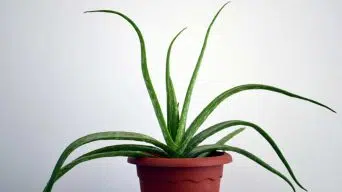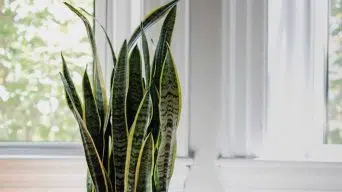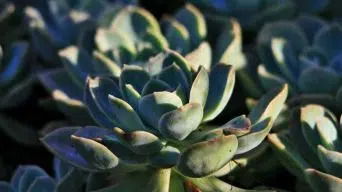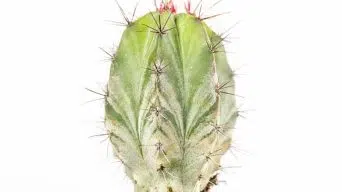Reviving a Snake Plant:
- Brown Leaves: Move to indirect sunlight, reduce watering, and ensure well-draining soil.
- Yellow Leaves: Increase bright, indirect light, water more frequently.
- Withering Leaves: Check for overwatering, move to shade, and adjust watering.
- Curling Leaves: Address environmental changes, pests, or overwatering. Repot if needed.
- Drooping Leaves: Check for overwatering, root rot, or cold drafts. Adjust care accordingly.
- Leaves Falling Off: Investigate overwatering, pests, or diseases. Treat and repot if necessary.
- White Spots: Fungal infection; treat with neem or lavender oil, remove affected leaves.
- Soft Roots: Indicate rot; trim, repot in fresh soil, gradually resume watering.
The Snake Plant, Dracaena trifasciata (formerly known as Sansevieria trifasciata), is a tough and resilient indoor plant that can survive in almost any environment.
They’re also one of the easiest plants to grow indoors, making them perfect for beginners.
However, sometimes, even the most resilient plants can have problems.
There might be many reasons a Snake plant looks unhealthy or dies, but don’t worry. There are solutions for almost every issue.
This article explores the causes and symptoms of Snake Plant issues, offering insights into the revival process for a Snake Plant.
Signs and Treatments for a Dying Snake Plant
A few telltale symptoms indicate your Snake plant is in trouble and needs help.
Treating the plant as soon as possible is essential to prevent it from dying.
The following are some of the most common signs that your Snake plant is struggling and the best way to fix them.
1. Brown Leaves
One of the most common signs that a Snake plant is dying is when its leaves turn brown.
Some plants have brown leaf tips or edges in their natural growth pattern.
However, if your Snake plant has significantly more brown leaves than normal, it is probably dying in need of help.
This is usually due to the succulent being overwatered.
Also, if the plant is in direct sunlight, the green leaves may turn brown due to sunburn.
To revive a Snake plant with brown leaves, place it in indirect sunlight and water it less frequently.
If the brown leaves are due to overwatering, you should also reduce watering until the problem disappears.
Make sure that the soil is always dry before watering it again.
Also, use a pot with proper drainage to prevent overwatering.
If the brown color is due to sunburn, move it out of direct sunlight and provide more shade.
Succulents thrive in indirect sunlight, so they should still get some light but not be in direct sunlight.
Also, ensure no warm objects like lamps are nearby, which could cause the plant to overheat.
2. Yellow Leaves
Like with brown leaves, if you start to see a lot of yellow leaves on your Snake plant, it is likely to die.
This is usually due to the succulent being underwatered, not getting enough light, or too much sunlight.
Not ignoring these warning signs is important because if you leave them too long, your Snake plant may die even with treatment.
To save a Snake plant with yellow leaves, place it in bright indirect light and water it more frequently.
If the yellow leaves are due to insufficient light or too much sunlight, you should move the plant to a new location where it can get more light but not direct sunlight.
If the yellow leaves are due to underwatering, you should increase watering until the problem disappears.
Ensure the soil is always dry before watering it again, and wait until the top inch of soil is dry.
Also, ensure you use well-draining soil and a pot with proper drainage to prevent overwatering.
3. Withering Leaves
Snake plants can naturally wither or droop their leaves due to stress.
However, if your Snake plant leaves are wilting and yellow for an extended period, it is dying and needs help.
This symptom usually occurs due to underwatering, overwatering, or over-fertilization.
But also, it could be a sign that the plant is getting too much direct sunlight.
If your Snake plant exhibits wilting leaves, you should remove it from any direct sunlight.
Then, place it in a shaded area and water the plant more frequently.
If the wilting leaves are due to underwatering, you should increase watering until the problem disappears.
If the wilting leaves are due to overwatering, you should decrease water until the problem disappears.
Just ensure the potting soil is always dry before watering it again, and wait until the top inch of soil is dry.
If the wilting leaves are due to overfertilization, remove any excess fertilizer.
Also, try not fertilizing your plant for a few weeks to see if the problem disappears.
4. Curling Leaves
If your Snake plant leaves start to curl, it may begin to die.
However, curling leaves do not always mean death; it could also mean the succulent is stressed.
This symptom usually occurs due to environmental changes, like sudden changes in temperature or humidity.
If your succulent starts curling its leaves and you haven’t changed anything in the environment, it may be a sign of overwatering or pests.
If your Snake plant shows signs of overwatering, you should stop watering it for a few weeks.
If the problem persists, you may need to repot the plant in a well-draining fresh potting mix.
You can also try increasing the humidity around the plant by placing it near a humidifier or spraying it with water a few times a week.
If the plant is infested with pests, you must take action and get rid of the pests.
There are many ways to do this, but some standard methods include using a pesticide or an insecticidal soap.
If the leaves are still curling after trying these methods, then it is likely that the succulent has root rot.
In this case, you must trim the damaged roots, repot the plant in a fresh soil mix, and give it some time to recover.
5. Drooping Leaves
If your Snake plant leaves start drooping, it is usually a sign of overwatering but could also be a sign of root rot.
Also, cold drafts can cause the leaves to droop, especially in the winter cold weather.
If you see this symptom on your snake plant and it hasn’t been exposed to cold drafts or overwatered, inspect its roots for root rot.
The roots will be mushy when rotting, and there may also be some black spots on them.
If your Snake plant’s leaves are drooping and may have root rot, you should try trimming the damaged roots and repotting the plant in a fresh soil mix.
Ensure the pot has a drainage hole, and water the plant sparingly until its new roots have grown.
If the leaves are drooping because of overwatering, you should stop watering them for a couple of weeks.
After that, you can water it more frequently in smaller amounts.
If the leaves droop due to a cold draft, move the plant to a warmer area.
But avoid putting it next to the heater because that will overheat the plant.
If you want, you can also cover some of its leaves with a bag or burlap sack if they are exposed to protect them from cold drafts.
6. Leaves Falling Off
If your succulent leaves start falling off, it is usually a sign of overwatering, but it could also be a sign of pests or diseases.
Overwatering can cause the roots to rot, making the plant vulnerable to pests and diseases.
If you see this symptom on your snake plant, inspect its roots for signs of root rot (mushy or blackened areas) and check it carefully for bugs underneath its leaves.
If the leaves are falling off because of overwatering, then you should stop watering it for a couple of weeks.
After that, you can water it more frequently with smaller amounts of water.
If the leaves are falling off because of pests, you should try to identify the bug and then eliminate it from your snake plant.
The most common pests are mealybugs, spider mites, and scale insects.
If the leaves are falling off because of a disease, you should try to identify the disease and treat it with a fungicide or insecticide.
If root rot is the problem, you should try trimming away any damaged roots, repotting them into a new potting mix, and watering sparingly.
The good news is that snake plants are very forgiving, and they will usually grow back if you treat their rotting roots or get rid of a pest infestation.
If your plant only lost a couple of leaves, reviving it shouldn’t be too difficult, as long as you catch its problems early on.
7. White Spots on the Leaves
If you see white spots on the leaves of your snake plant, it is usually a sign of a fungal infection.
White spots on succulents are most commonly caused by a fungal disease called powdery mildew.
This disease causes a white powder to form on the leaves, and it can eventually lead to the death of the plant.
If your snake plant has white spots, you should treat it with a fungicide.
The best way to get rid of powdery mildew on succulents is by using neem oil or lavender oil, but be careful not to use too much!
I recommend only putting one drop on each affected leaf and repeating the process in two weeks if needed.
If your plant has many white spots, you may need to use this treatment a few times.
You should also try cleaning the leaves with a damp cloth and removing dead or dying leaves.
8. Soft and Mushy Roots
If the roots of your snake plant are soft and mushy, it is usually a sign that they have rotted.
Rotting roots usually indicate overwatering, but pests or diseases can also cause them.
When the roots are soft and mushy, remove the plant from its pot and trim the rotten roots.
Then, repot the plant in fresh soil and don’t water it for a week.
After a week, you can start to water the plant lightly and slowly increase the amount of water over time.
Ensure the potting soil is completely dry before watering your snake plant again.
You should also inspect the plant for other signs of disease or pests.
If you are careful with your watering, this snake plant will grow back stronger than ever!
If it is too late and there is no hope left for the dying snake plant, you can start from scratch by propagating a new Snake plant from a leaf cutting.
Maintaining Optimal Conditions for a Thriving Snake Plant
To ensure your snake plant remains robust and vibrant, it’s crucial to implement preventive measures that ward off decline.
By creating an environment tailored to its needs, you can significantly contribute to the long-term well-being of your snake plant.
Here are key strategies to prevent your snake plant from experiencing a decline:
- Appropriate Light Exposure: Position your snake plant in a location with indirect sunlight. While snake plants are known for their resilience in low-light conditions, prolonged exposure to intense sunlight can lead to leaf burn. Striking the right balance ensures your plant receives the necessary light for photosynthesis without causing stress.
- Balanced Watering Routine: Overwatering is a common pitfall for snake plant enthusiasts. Allow the soil to dry out between watering sessions to prevent root rot. Ensure proper drainage in your plant’s pot and adjust the watering frequency based on the specific needs of your environment.
- Well-Draining Soil: Use a well-draining potting mix to promote aeration and prevent waterlogging. A mix designed for succulents or cacti is often suitable for snake plants. Adequate drainage ensures that excess water doesn’t accumulate at the roots, reducing the risk of fungal infections.
- Optimal Temperature Range: Snake plants thrive between 70-90°F (21-32°C). Avoid exposing them to extreme cold or drafts, leading to stress and disease susceptibility. Keep your plant in a stable and comfortable environment to encourage steady growth.
- Periodic Fertilization: While snake plants are known for their low-maintenance nature, providing occasional nutrients can enhance their vitality. Use a balanced, water-soluble fertilizer during the growing season (spring and summer), following package instructions for application.
- Pest Vigilance: Regularly inspect your snake plant for signs of pests like spider mites or mealybugs. Early detection allows prompt intervention, preventing infestations that could compromise plant health.
By incorporating these proactive measures into your care routine, you’ll create an optimal habitat for your snake plant, reducing the likelihood of decline and promoting a flourishing, resilient botanical companion.
Final Thoughts
Snake plants are incredibly resilient and easy to care for, but even they have their limits.
If your snake plant starts showing any of the symptoms listed above, it is probably time to intervene.
Luckily, most of the treatments to revive succulents are simple and straightforward.
However, if the plant does not improve after a week or two, it might be time to give up and buy a new one or try to propagate the old one.







